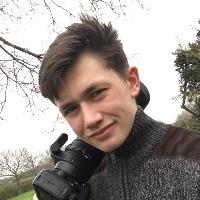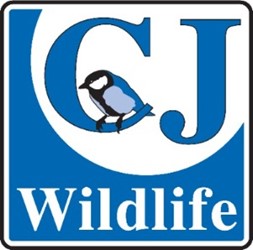So here I am, sat on my Laptop, in my brand-new Birding Office. The day is Thursday the 18th of July and I returned to England 3 days ago following possibly the best set of combined experiences of my life to date. My inspiration and motivation are persistent as a result of a truly fantastic event.
This event was the Cornell Lab of Ornithology’s Young Birder’s Event 2019, which the Cameron Bespolka Trust very kindly awarded me the scholarship for, for only the 4th time. To say I am grateful would be an understatement. Only now has it hit me just how amazing the event, the people involved, and the place it was at actually are. In recent years, the Cameron Bespolka Trust have been shipping one young person over to the states on this event each year. Last year, my good (albeit rather new) friend Elliot Montieth jetted off for the event, and before that Max Hellicar and Amy Hall also attended in 2017 and 2016 respectively.
To say I am grateful would be an understatement. Only now has it hit me just how amazing the event, the people involved and the place were
The event was coordinated by a core group of 3 people, but was impacted by almost everyone in Cornell. Jessie Barry, who is program manager, Chris Wood, assistant director of Information Science and a developer of eBird, and Ian Davis, and incredible birder and eBird Project Coordinator.
DAY 1: WEDNESDAY 10TH JULY 2019
The journey started with an early start in to catch the National Express Coach from Ringwood in Southern Dorset to Heathrow Airport’s Terminal 5. Once through the airport and up in the skies I tried to focus on brushing up my massive American bird knowledge gaps, but the turbulence was quite head pounding and my revision was not so productive.
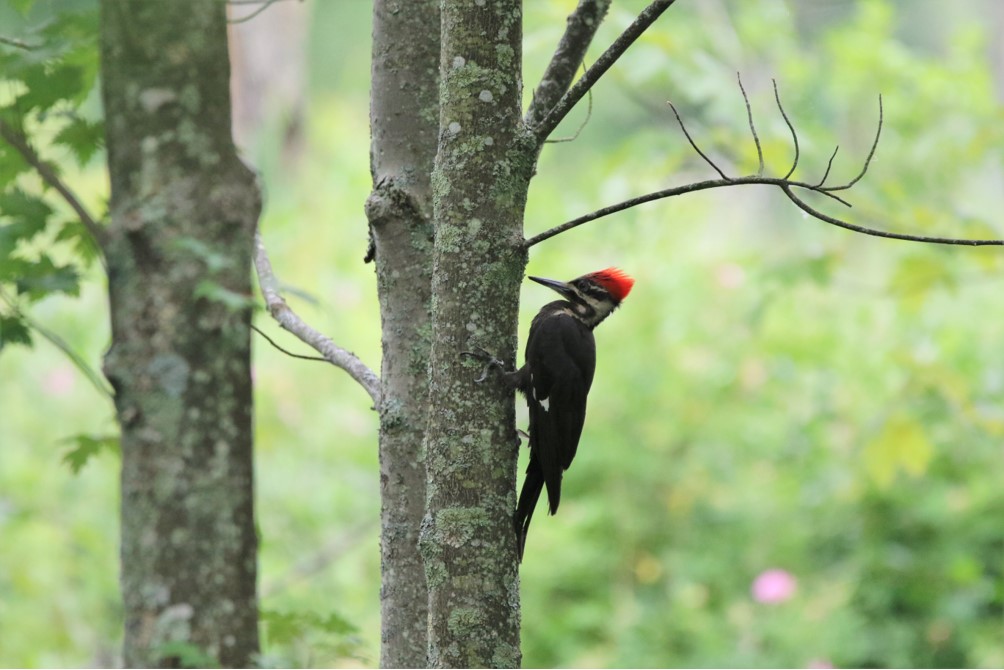
Pileated Woodpecker. Photo: Alex Chapman
Once landed, it became apparent that Philadelphia Airport is a bit of a pig to get through – and after a very stressful 45 minutes in customs, I sprinted from one end of the airport to the other, to just (and JUST) catch my connecting flight to Ithaca.
Once landed in Ithaca, the troubled feeling continued because after having a gut feeling that my luggage hadn’t arrived… it hadn’t! In my haste, I was totally unaware of Jessie Barry, a wonderful person and the main coordinator of the event, waiting to greet me at the airport. Once my luggage was set on the right path and greetings had been done, we headed off to the hotel along with two of the other young birders, Estevão from Brazil, and Eliana from California – we all instantly hit it off and all became very close friends.
After a relaxed meal with Jessie, Estevão, Eliana and Chris Wood (another incredible chap), I was pleased to hit the pillows in the massive hotel bed – but the serenity wasn’t long lived because after just a few hours’ sleep, I received a call to say my suitcase had arrived! Knowing full well I had to be up at 0500 hours and out of the door by 0530, sleep was calm but relatively light.
DAY 2: THURSDAY THE 11TH JULY 2019
The morning was a memorable one. My first ever experience of birding in the states with Chris Wood and Eliana. I decided to leave my photography equipment in the vehicle to focus on learning the US birds and having a more fulfilled experience. In both of our birding locations that morning, I regretted this because sightings were close and abundant in a variety of species, almost all of which were lifers for me.
The fresh, humid air of Myers Point on the edge of Lake Cayuga at something to 6 in the morning was serene, and everywhere I looked was a lifer. Whether this was a Belted Kingfisher, much larger than our ones, darting down the boggy channel, or a Baltimore Oriole swiftly moving over head – everything was new and exciting. Northern Flickers were also showing beautifully along the road side. I did however have a slight hang up on the American Robin, mainly because of its dissimilarity to our flycatcher-type robin!
After Myers Point, we moved off to another part of the area, briefly stopping off for breakfast in an authentic bakery. We moved on to a place called Summer Hill State Forest where I had my first introduction to a bird luring technique, commonly known as playback. Avian highlights from the ordeal included Yellow Bellied Sapsucker, and the beautiful, aforementioned Blackburnian and Chestnut-Sided Warblers. This was the first time the density of birds in the region really hit me, as within seconds of the tape running, a rotation of many individuals of at least 12 species continued to rotate about the source of the lure.
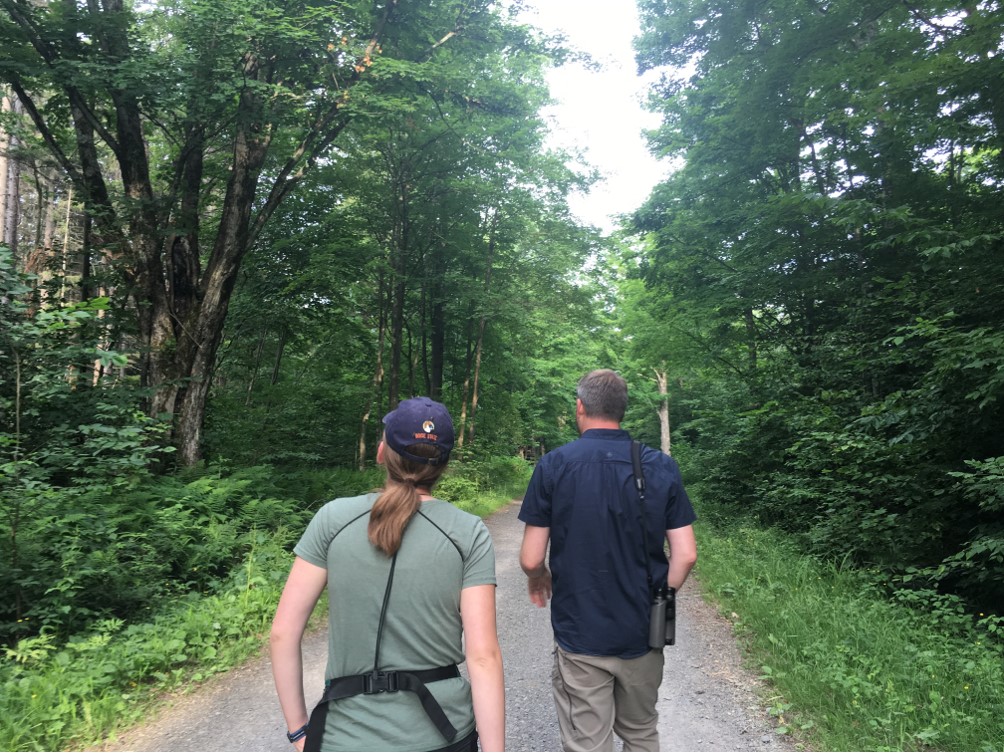
Exploring Summer Hill State Forest
We then stopped in a place called Groton. Here a few chimney swifts, and a huge number of Turkey Vultures could be sighted above the forested ravine. Being my first wild vultures, I was ecstatic with the sighting.
On reflection, leaving my camera out was a great thing, to experience American Birding properly and to just enjoy learning and being where I was without the photography stress, was superb.
Soon after this thought had struck my mind, it would have appeared as if we had arrived at the Cornell Lab of Ornithology. We slipped in one of the back doors and Chris kindly showed us to the office of 14-year-old Estevão. His affinity with the labs gave a couple of us a unique insight into the daily processes of the lab – and allowed us to meet some incredible people we would otherwise not have met. One lady in particular had just finished coordinating the production of an advert lengthened documentary highlighting the importance of dwindling African vultures – it was most interesting.
We then went birdwatching in Sapsucker Woods, around and about the lab, where I got my first looks at Pileated Woodpeckers (a pair). It was a great view too! Also encountered was a brilliant view of a Red-Tailed Hawk – which was being mobbed by about a dozen other birds whilst it sat in a tree then flew off.
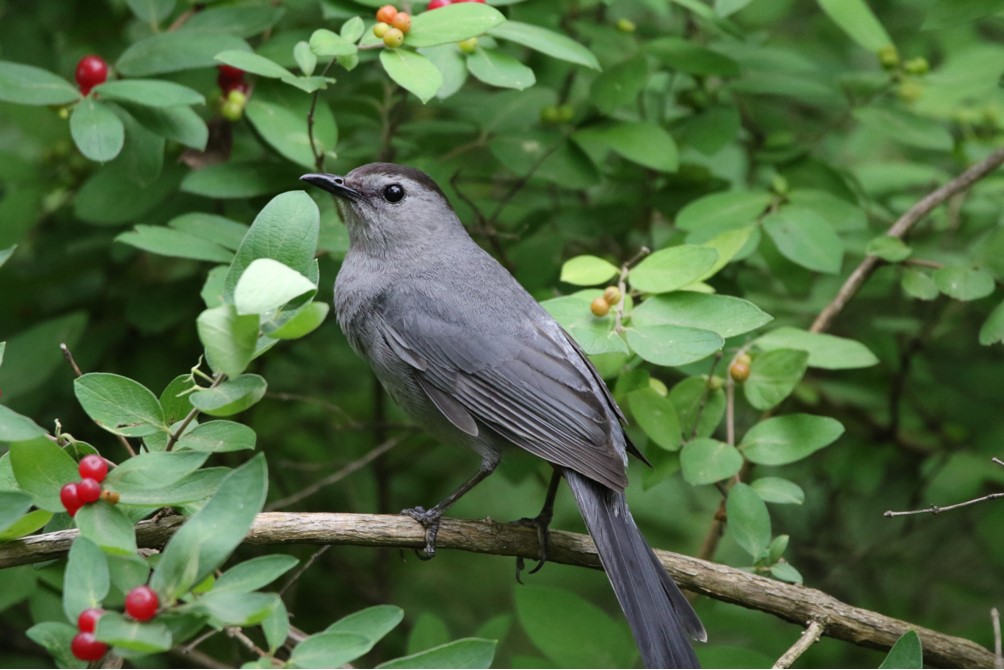
Grey Catbird. Photo: Alex Chapman
Shortly after this, the Cornell Young Birder’s Event officially began, and the other participants all arrived to collect a bag of goodies. So many great items were handed out, including books and t-shirts. A special gift from the event sponsors, Zeiss, were some high quality, special edition binoculars- a gesture fully appreciated by all. Following a brief introduction to each other and an introductory talk, we a of interesting and intuitive talks, which certainly helped introduce me to the idea of birding in the US and the structure of pursuing ornithological interests as a career. These talks came from John Fitzpatrick (the executive director), who spoke about different institutions that offer a form of ornithology, and student, Sarah, giving a basic ornithological undergraduate experience talks to name a few.
Then it was off to the ‘eco lodge’ for our dorms. I roomed with a new life-long friend, Cameron from Maryland, and I’m planning a trip to DC and Arizona to meet him next year and do some more US birding!
DAY 3: FRIDAY 12TH JULY 2019
Today was a standard 5am start – with a hazy breakfast after such a full and compact day yesterday. After jumping on a mini bus, half of us headed Shindagin Hollow State Forest whilst the other half headed elsewhere. We started the day Sound Recording. I have never experienced this before so this was entirely new for me and thoroughly enjoyable once I had got to grips with how to use the equipment, along with once I had the confidence to say what species I was recording!
My sound recording was done alongside my Brazilian counterpart, experienced 14-year-old, Estevão. This lad is one of the most unbelievable and talented young gentlemen I have ever met, and to be so influential in Brazil at his age is quite something – he is even an expert on North American birds having just spent 6 weeks there! Estevão explained how he recognised the different calls and showed a really professional way of recording – along with help from Jessie, who stayed behind to give us tips now and then.
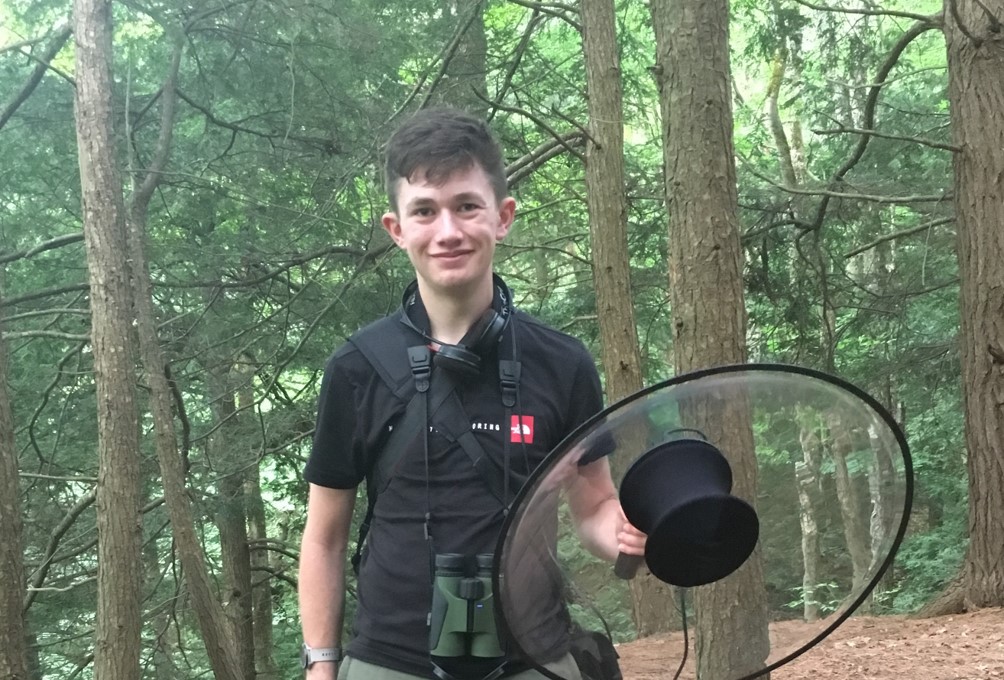
Sound recording was a new exprience
The forest was simply stunning, and so varied, with huge steep slopes down towards the river in the gorge, and as the sun climbed higher into the sky and lit the forest – we moved on to our second destination for the morning. Sound recording highlights included great performances by a Scarlet Tanager male and a Black Throated Green Warbler. There was also a short but brilliant visit from a Sharp-Shinned Hawk for me and Estevão – which was quite special.
The next location for some bird watching was the Roy H Park Preserve, another short drive away. This preserve didn’t appear to be rich in wildlife, but after a short walk and some more lure tapes, the species began to role in and it became apparent that this was a great spot. There were chickadees left, right and centre, chestnut-sided warbler and a favourite of mine – the Magnolia Warbler, which posed beautifully for what is possibly one of my best shots ever. Two Barred Owls were also heard calling quite near buy, but we had no luck seeing them. This walk lasted an hour and a half- just like the sound recording before it.
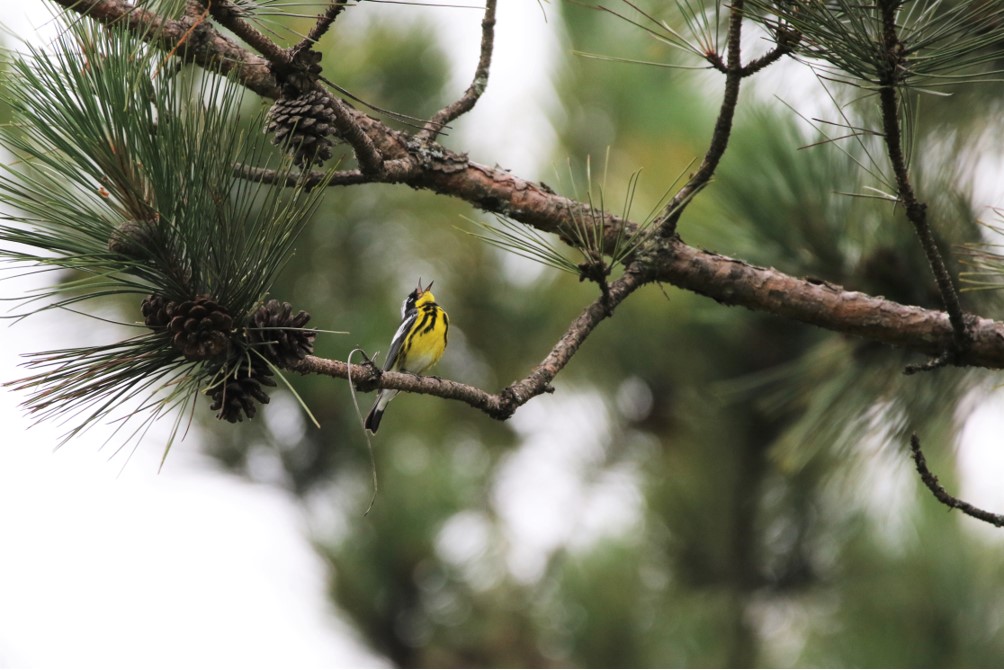
A Magnolia Warbler. Phoot Alex Chapman
Lunch followed this, some good American sandwiches, which was then followed by some more intuitive talks regarding our sound recording of the morning, which had been neatly edited by Jay McGowan from the sounds department of the Macaulay Library, further talks from undergrad student Sarah, and other people from the lab. This was all quite intense and I struggled to retain concentration due to slight jet lag, but I feel like I picked up what I needed and what was relevant to me.
I also had to conserve some energy for the next exciting tour of the Specimen Archives within the lab. Everyone thoroughly enjoyed this tour, and it began with an introduction as to how the study skins are prepared and sourced. There was a new delivery of specimens that had just been prepared from somewhere in the middle east. It was laid out in a way that allowed us to see the process step by step.
After this we headed into the archive, and my word, what a collection. After being shown the extinct and critically endangered cabinet – with Passenger Pigeons, Ivory-Billed Woodpecker, Darwin’s Finches and a Harpy Eagle being the ones I was most excited about. This cabinet, and the set aside Birds of Paradise, was all that was off limits in a collection some 57,000 individuals strong. Given what would be considered a relatively short 2 hours, we thought quickly about what we wanted to find, and set off (almost completely not at all) systematically. My first point of call was the Coraciiformes, which included the likes of Kingfishers, Kookaburra, Bee Eaters and Hoopoe. These compact birds are of particular interest to me thanks to there highly adapted compact bills and their wide variety of colour pigments. Other highlights were Cassowary, Magnificent Frigatebird and the startling aray of Hummingbirds – from an iridescent 70-year-old specimen, to a sword-billed beauty - but that was a tiny fraction of the huge number of birds I, personally, got to handle and examine.
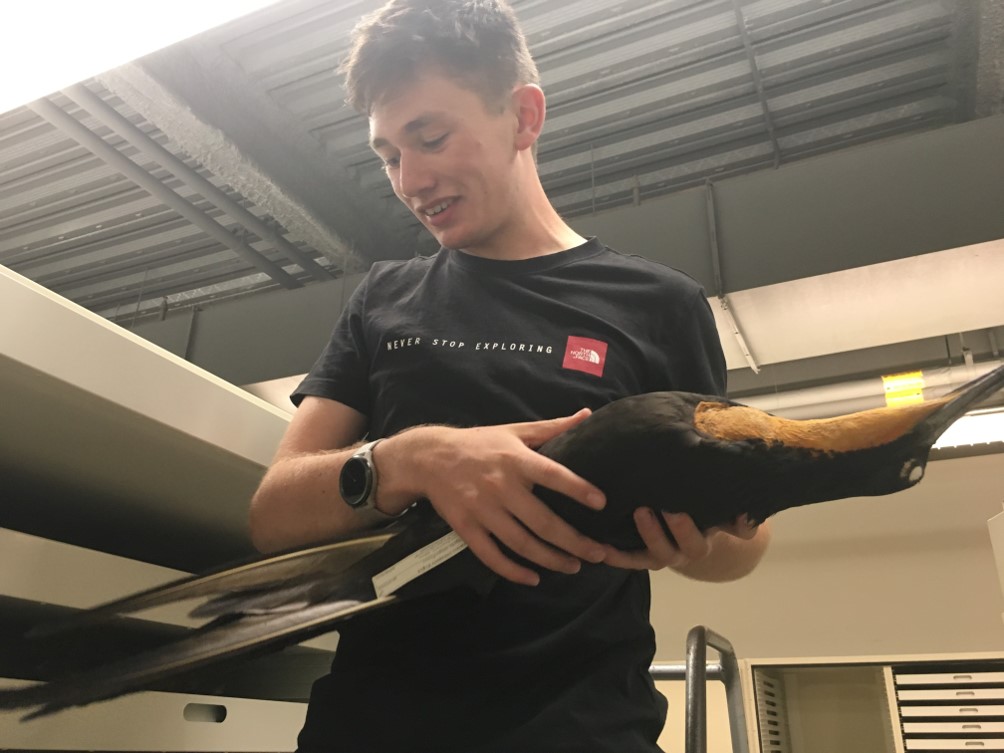
A tour of the Specimen Archive
After this excitement, we headed back to the lodge, where we played pool, foosball and table tennis for a few hours, before hitting the well-earned hay.
DAY 4: SATURDAY 13TH JULY 2019
The next morning, we were up standardly early again, and we jumped aboard the mini buses and headed up the finger lake of Lake Cayuga to Montezuma National Wildlife Refuge. On our way we passed many osprey – a familiarity for the Americans, but a cause for excitement for me once again!
Upon arrival at the visitor centre of Montezuma, we were greeted by a pleasant collection of purple martins, along with a few distant Bald Eagles, and two American Bittern. The day started nicely! Solitary Sandpiper were also nice to see. After this beautiful spot, we continued onwards to some other locations around Montezuma’s Wildlife Drive. Highlights for me here, included more Bald Eagles, a Caspian Tern, Eastern Kingbird and an unbelievable family of Sandhill Crane, including a just visible chick, wandering between the half a dozen Bald Eagles, placed seemingly strategically like chess pieces about the wetland.
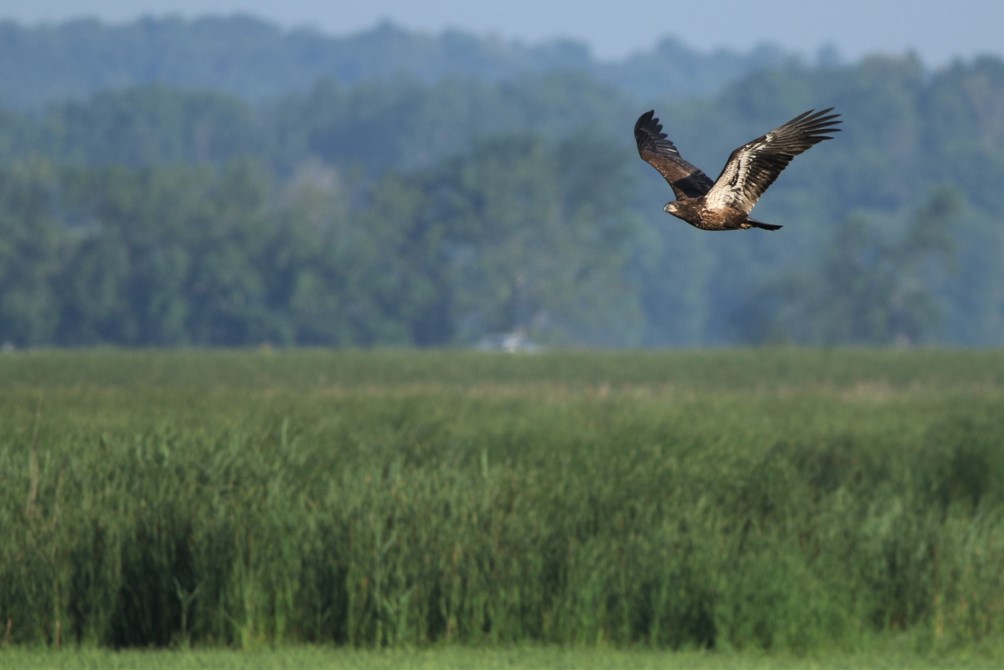
Juvenile Bald Eagle. Photo Alex Chapman
We then moved on and tried for Cerulean Warbler. We got about 4 which was a great number, and a lifer for some of the other American young birders- let alone me. It did involve taping to get them in, but regardless of your view on taping, it was nice to see them considering we had such a small amount of time to find the almost 150 species we found on the trip!
In another Montezuma location, we added more species to our trip list – including a great sighting of a snow goose, a double crested cormorant, and, whilst it isn’t a bird, an iconic Monarch Butterfly was a pleasure to watch.
Soon after this we headed for lunch in a nice restaurant in the baking heat on the decking overlooking the middle of Lake Cayuga. Whilst many more Osprey were sighted in this single location – my total hit about 44 – which is a little less than Elliot’s total last year.
After a failed attempt to find upland sandpiper on a tip off location, we headed back towards the lab – gladly the sandpiper wasn’t seen because the jet lag finally caught up with me and I was out for the count! Before I knew it, I was being woken back at the labs where some of the most intuitive talks were held.
‘R’ is a programming language and free software environment for statistical computing and graphics which helps to map out species distributions and lots of other data in the lab. We were given a quick crash course on ‘R’, and it would appear is if it is very prominent in the work of the lab. A few of us also stayed behind to have a bit more of an in-depth insight into the workings of ‘R’ – this is certainly a tool worth using in the world of data analysis.
After our last supper together, we all regathered in the main lecture room for one of our final presentations. It was done by Andy Johnson (and Irby Lovette), a photographer and filmmaker associated with the labs who has been to most corners of the Earth. The talk was about conservation media, and it was inspiring and empowering, and showed the lengths that commissioned and non-commissioned photographers and film-makers go to, to document and study rarities and endangered species in some of the harshest areas on the planet. He talked most specifically about St. Matthew Island and the McKay’s Bunting in the Bering Sea of the North Pacific.
After this awakening talk, we headed back to the Lodges for the last time – where most a few of us stayed up uncomfortably late to make the most of the social side of the event. This involved table tennis, piano, and trip planning. After this, we went to bed – ready to get up a few hours later on what was now the same day.
DAY 5: SUNDAY 14TH JULY 2019
This morning we left at the standard 05:30, but I had to get up earlier to pack my- almost unnecessarily large amount of clothing and stuff. Then we set off for our last birdwatching trip together as the Cornell Young Birders 2019.
This trip took us to the Lindsay-Parsons Biodiversity Preserve – a whole new experience of habitats, where we got our first glimpse of the beautiful Black-Billed Cuckoo along with a beautiful and clear series of its call. Here, we also got a brilliant Porcupine sat right at the top of a tree – now that was quite something as none of us were expecting that, and it was very close too! There was also a Great Egret or two about – which are also supposed to be quite rare, and we got good views of Indigo Bunting and Scarlet Tanager.
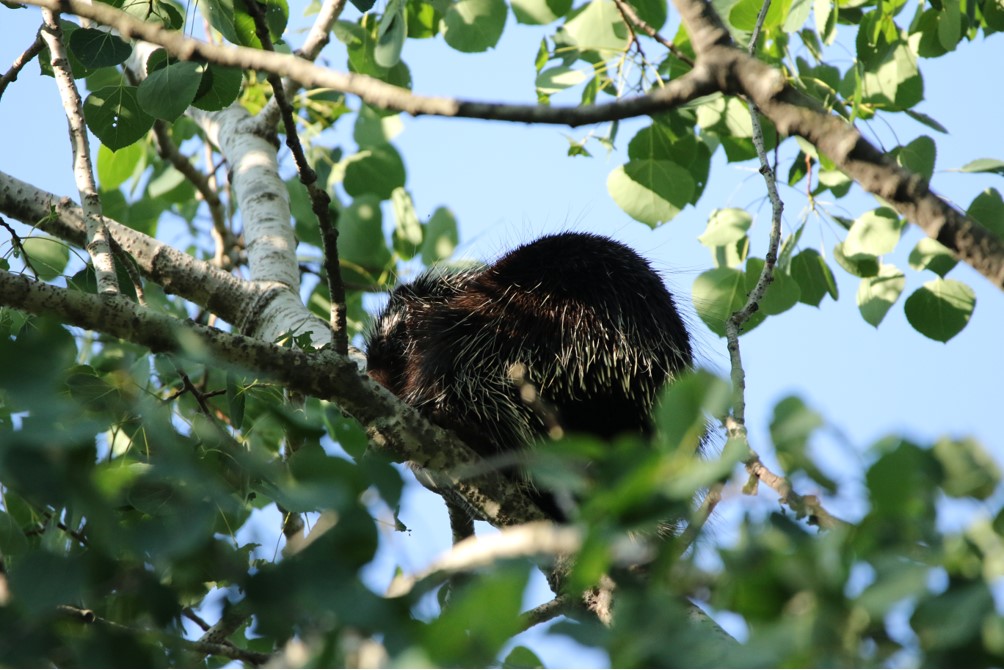
Porcupine nestling in a tree. Alex Chapman
After this exciting affair we headed off to some other sites – where sightings included yet more lifers for me – which included Virginia Rail and Sora, Grosbeaks, and a Broad-Winged Hawk. On our second to last location, we had another sighting that no one was expecting. In my new friends’ haste to get me to see a Ruby-throated Hummingbird, one was spotted in a nice area of woodland which I actually saw, then it was lost by all. Shortly afterwards, it was rediscovered to be sat on a nest about the size of a 2 pence piece. To see such a small bird with such a high metabolism sat on a nest was quite exciting, and gave a whole different perspective for me on them. I was thrilled with the sighting, as was pretty much everyone else.
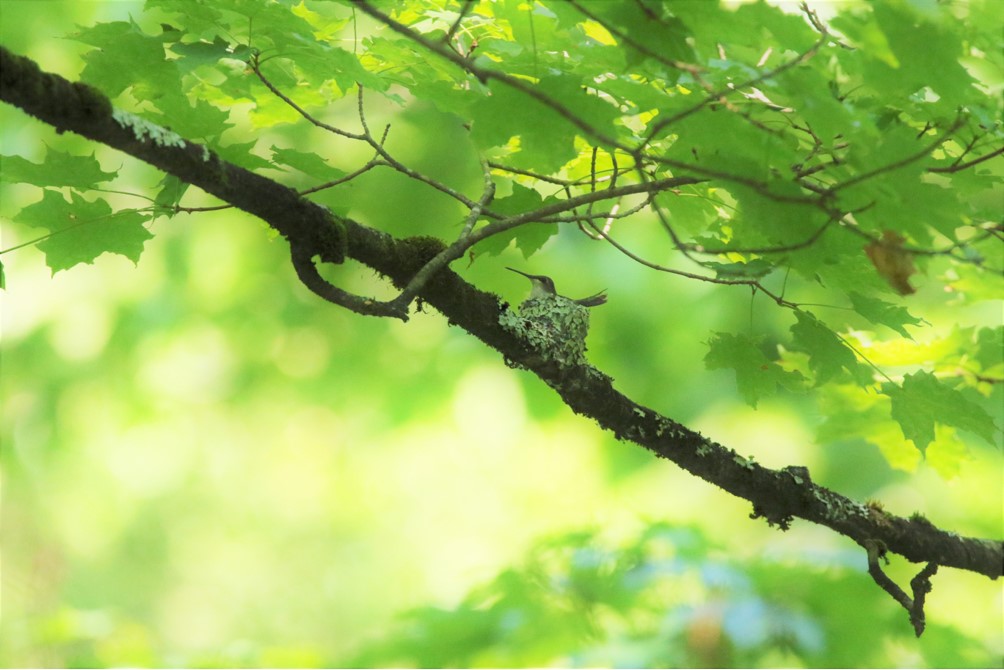
Ruby-throated Hummingbird. Photo: Alex Chapman
The last locations threw up another hummingbird – a male this time, along with a nice overview of the general easy-to-come-by species around New York’s Finger Lakes. These trips were followed by a visit back to the Lab where there was a final talk and a chance to thank everyone and say goodbye. I however, still had most of the day until my flight left, so I joined a campus tour where Chris, Jessie, and myself did some bird counts at the back – the campus, however, is unbelievably beautiful and the architecture is sublime. Ithaca is also extraordinarily clean.
As my flight took off in the golden and crisp evening from Ithaca Airport, I felt a huge sense of fulfilment completely take over my body. After a tough year, I felt like I had never felt before, happy, proud, excited and fulfilled are the main words to describe it. I opened the pages of Wilding by Isabella Tree and continued reading whilst listening to Billy Joel’s New York State of Mind. My life had been changed for ever.
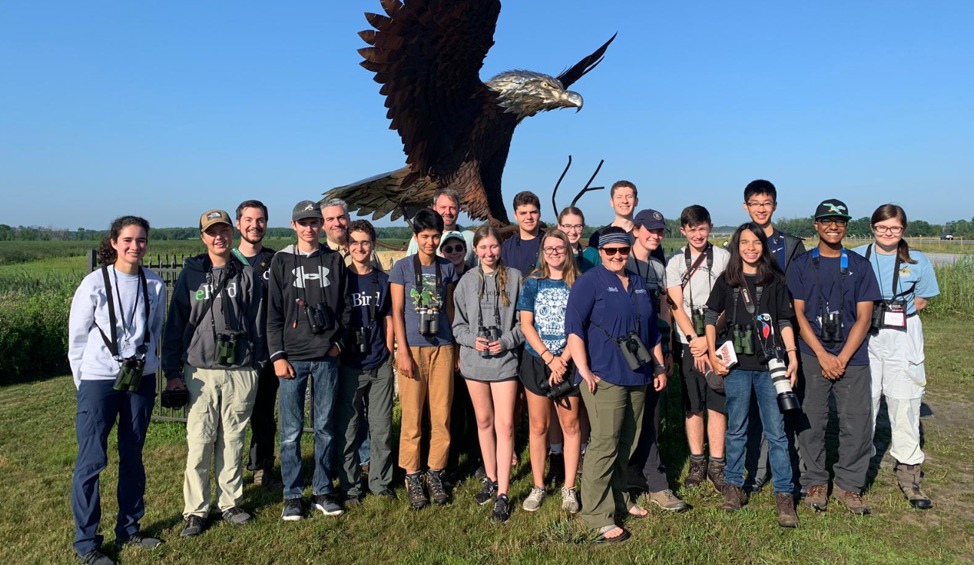
Class of Cornell Bird Event 2019
Before I knew it, two flights, two seats to myself from Ithaca to Philly, three seats to myself from Philly to Heathrow, and a load of shut eye, I was home and ready to put my motivation into action.
Since I have been home, I have really set to work at making a difference. My first point of action was to buy a new birding desk – success. It was because of that, that I could carry my Cornell inspiration onwards back here in the UK, and I have since been out birding, meeting new people, volunteering, getting involved with projects and planning new trips, endlessly – at some point I will have to think about my A Levels again – but that will all come in time! For now, I live for nature, and that’s how I want to live my life – I can’t wait to continue to work and hopefully have a positive impact on birding for all.
Birding isn’t just about competition between birders for life lists and the best photos, it is also about sharing what is available to all of us with those people who don’t always see or appreciate it. We need to welcome new birders with open arms and give more people, young and old, the opportunity to become a serious birder. In the US, something like 1 in 3 people will go specifically birding at some point in their life – here, that figure is a fraction of that. That can be changed through positivity and a rethink of the way we advertise bird and wildlife watching as a hobby.
A birding revolution is happening in the UK, it is becoming more popular and it is becoming more accepted. Times are changing, and positivity towards birding and within the birding community is getting there. More of us welcome the young, welcome the old, welcome the LGBTQ, all races, all genders, and welcome all other previously discriminated members of society, and if we accept all birders for their love of birds, the changes people want to see WILL happen. Climate change only highlights how all wildlife and nature loving communities gain momentum and see eye to eye.
I would just like to thank everyone involved in the process of my inspiring trip to Cornell. Thank you to Chris, Jessie and Ian for being the best mentors, everyone at Cornell for the inspiring talks and meetings, Elliot for your support throughout, Keith for your continued support, and what could be considered most importantly, Corinne and everyone at the Cameron Bespolka Trust for changing my life and giving me the opportunity to have a platform in which to hopefully spread my wings in the ornithological world. I’d also like to say a special thanks to Cameron, Estevão and Eliana for being some really great friends to meet along the way. Finally, thank you to anyone reading this, I hope you all enjoyed my experience, and I hope that anyone who dreams of it, can experience something similar in their lives.
